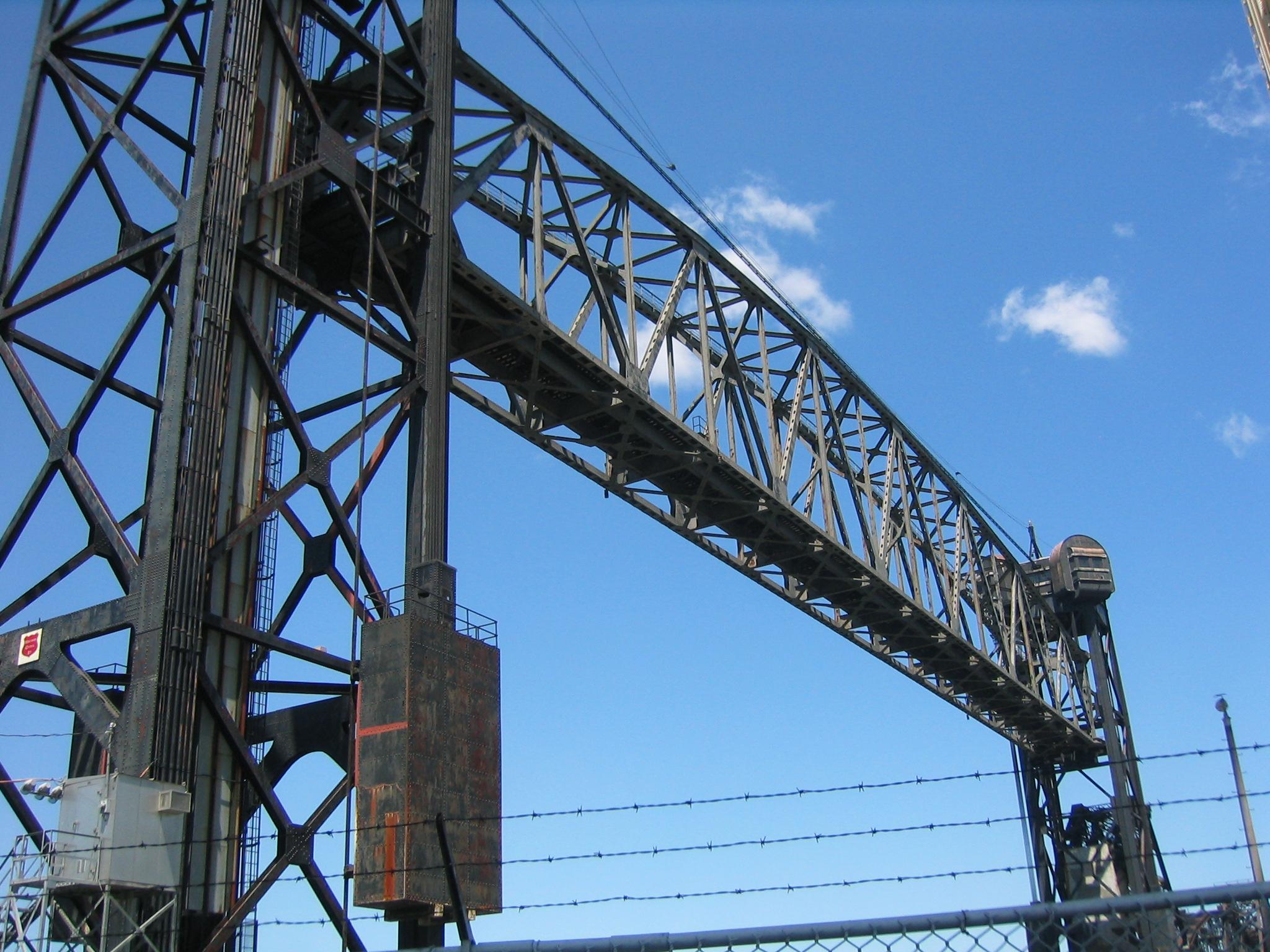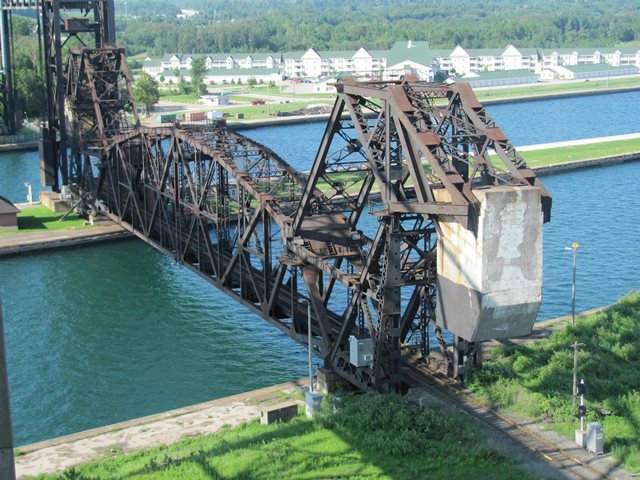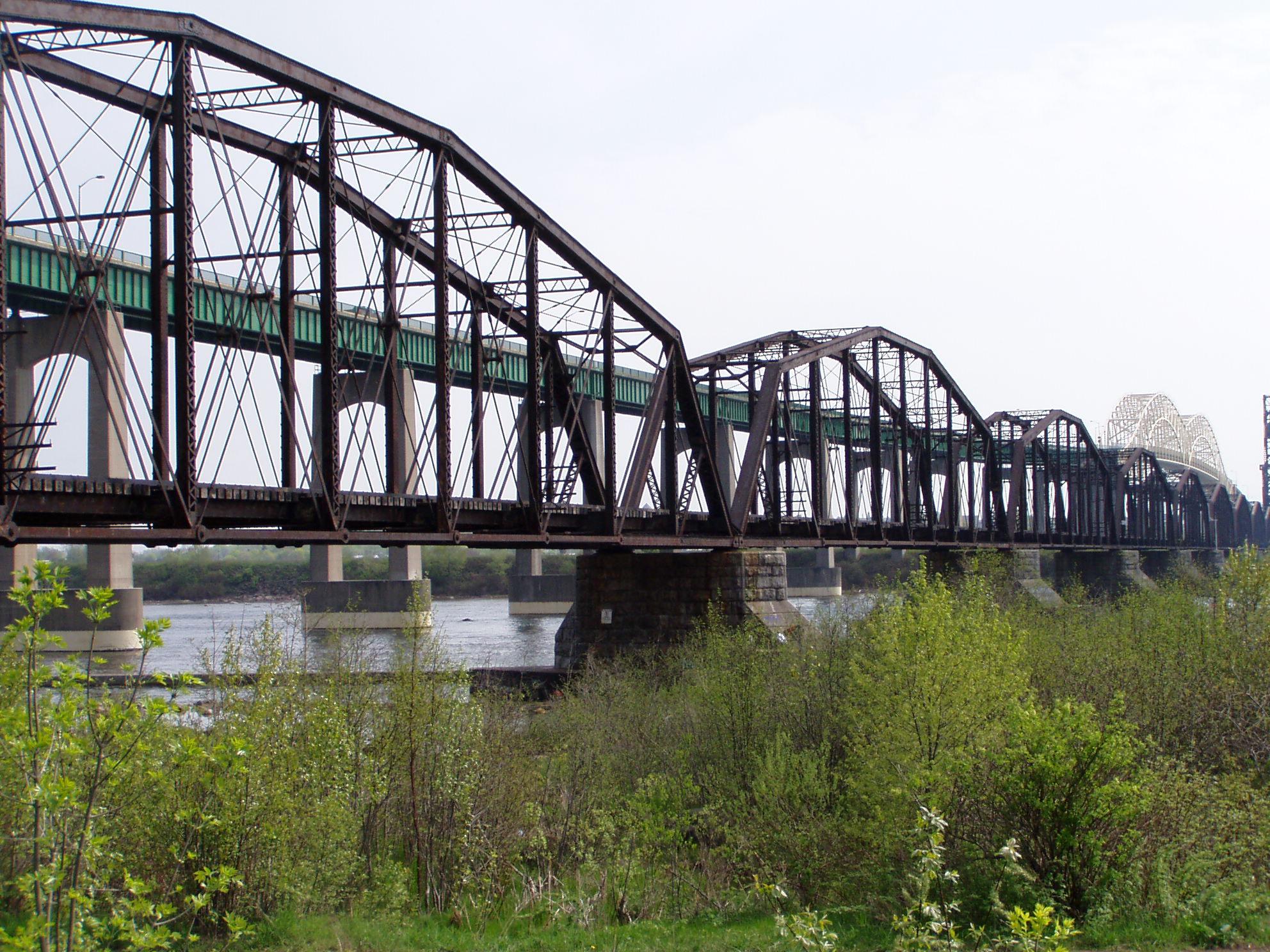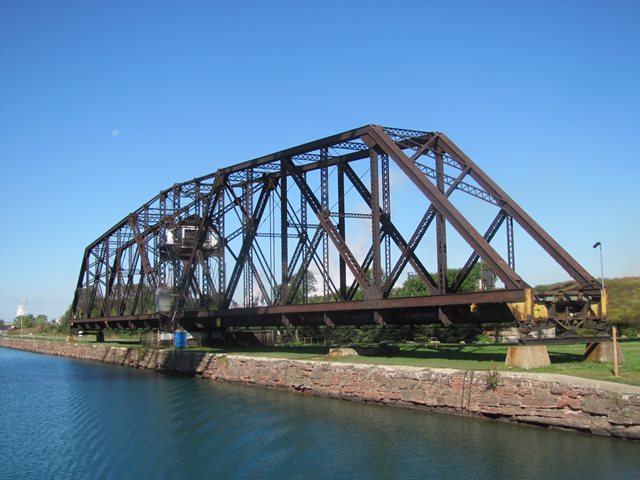We Recommend:
Bach Steel - Experts at historic truss bridge restoration.
International Railroad Bridge
Sault Ste. Marie International Railway Bridge

Primary Photographer(s): Nathan Holth
Bridge Documented: May 14, 2006, Summer 2011, September 6, 2014, and June 4, 2017
Railroad (Wisconsin Central) Over St. Marys River and Associated Canal System
Sault Ste. Marie: Chippewa County, Michigan and Algoma District, Ontario: Canada and United States
Metal 8 Panel Pin-Connected Camelback Through Truss, Fixed and Approach Spans: Metal 12 Panel Rivet-Connected Pennsylvania Through Truss, Movable: Double Leaf Bascule (Heel Trunnion)
1887 By Builder/Contractor: Dominion Bridge Company of Montréal, Québec and Engineer/Design: Strauss Bascule Bridge Company (Strauss Engineering Company) of Chicago, Illinois
1913
369.0 Feet (112.5 Meters)
5,580.0 Feet (1700.8 Meters)
21 Feet (6.4 Meters)
9 Main Span(s)
Not Applicable

View Information About HSR Ratings
Bridge Documentation
Additional information about this bridge is available in a HistoricBridges.org Presentation. View The Presentation.
View Historic American Engineering Record (HAER) Documentation For This Bridge
HAER Data Pages, PDF - HAER Original Plan Sheets, PDF
View Historical Article About Bascule Span Accident
General Overview of Bridge
The International Railroad Bridge is a magnificent landmark bridge whose significant size comes from a large number of smaller spans, rather than a single large bridge. Indeed, the bridge is unparalleled in its variety of span types. It is one of the few bridges in North America to have more than one type of movable span. It is one of the few bridges in North America to have more than one type of movable span. Indeed, within this bridge each of the three most common movable bridge types is represented. When all these sections are combined, the result is a bridge that is unrivaled in variety, size, beauty, and history. These separate and different structures that carry the railroad over the St. Mary's River and its canal systems are collectively referred to as the International Railroad Bridge. The bridge was designed for and continues to carry a single set of tracks. In addition to the variety of span types, the bridge's existing spans were also constructed at different times. Two dates are most significant in the bridge's history. First, is 1887, which is what the oldest spans on this bridge date to, including the fixed camelback spans and the swing bridge. The second most significant date is 1913 when the Strauss Bascule Bridge Company designed the largest (and one of the most unusual) bascule span in the world for this bridge. Because of the variety of span types and span ages, photo galleries for this bridge as well as the narratives have all been organized into separate sections by bridge span type. The bridge crosses the river and canals of St. Marys River by making use of islands, some of which are artificial islands created by the locks. As such, from a technical definition, this bridge could be thought of as several bridges, since there are a few short sections that has track running along the ground. However, the structure is generally referred to in discussion as a single bridge, and therefore this bridge is being presented here on HistoricBridges.org in that format.
General Arrangement and Dimensions of Spans

The bridge is composed as follows from south (United States) to north (Canada). First, a deck plate girder span. Second, a vertical lift span dating to 1960. The vertical lift span has a span length of 369 feet (112.5 meters). The bridge span width is 21 feet (6.4 meters). The lift span is a rivet-connected polygonal Warren through truss with 14 panels. Next is a double-leaf bascule bridge designed by the Strauss Bascule Bridge Company in 1913. This bridge has a span length of 336 feet (102.4 meters). It was built by the Pennsylvania Steel Company of Steelton, Pennsylvania. It has a width of 23 feet (7 meters). Next are nine fixed pin-connected Camelback through truss spans. Each span is 238.5 feet (72.7 meters) between bearings and the bridge's eight panels total 191.1 feet (58.2 meters). These spans were built in 1887 by the Dominion Bridge Company of Montreal, Quebec. Built in 1895 is a through truss swing span. The bridge is a center pier symmetrical swing bridge, yet only one half of the swing actually extends over the canal, while the other end crosses only the island that the pier rests on and acts as a counterweight. Finally, there are a series of fixed deck plate girder spans.
The roughly estimated overall length of bridge from end to end including island sections, is 5580 feet (1700.8 meters).
About The Fixed Camelback Truss Spans
This bridge is the true international portion of the International Railroad Bridge, since one end is in Canada, the other is in the United States. Canada has done a far better job than the United States in making the St. Marys River and canals accessible and enjoyable for the public to visit. On the Canadian side, it is one huge park area. Second, although this is an international bridge, you can still walk right up to it and get photos. Although there are undoubtedly many security measures at the center of this bridge, no restrictions prevent photographers from getting a photo of the beautiful portal of this bridge. This is all a stark contrast to the security fences and buildings that all but completely block the portions of the International Railroad Bridge on the U.S. side of the river.
The bridge itself is utterly magnificent and is composed of an impressive nine spans! Each span is ten panels. The bridge is significant for its early construction date of 1887. The bridge was built by the Dominion Bridge Company of Lachine, Quebec, as described by the builder plaque. Lachine refers to an area within the city of Montreal. The trusses are Camelback truss spans, and feature pinned connections. There is v-lacing on the verticals, sway bracing, and under the top chord/end post. The portal bracing is an a-frame design. Piers and abutments are stone, with portions of concrete added.
Above: Early 20th Century Photo of Bridge. Source: Library of Congress
About The Swing Span
This swing bridge is a large span. The southern half of the bridge does not cross any water, and simply provides balance to the weight of the structure. This method of balancing the bridge is in contrast to the use of bobtail swing bridges like the North Avenue Railroad Bridge in Chicago. This swing span of the International Railroad Bridge was built in 1895.
The swing bridge is of considerable length. The truss configuration of this bridge uses a Baltimore design. There is extensive v-lacing and lattice on this bridge, including some members that have v-lacing or lattice on all four sides. The bridge is a pin connected structure, however an inspection of the connections leads to the discovery of an alteration. The railroad company appears to have at some time appeared to tried to make some of the connections rigid, by bolting on new steel to some of the connections. As a result some of the connections today function as rigid bolted connections.
About The Bascule Span
View Historical Articles About The Bascule Bridge
This section of the bridge is the most difficult to get photos of which is extremely frustrating because this is an extremely historically signifcant structure. Located north of the vertical lift is this magnificent and highly unusual double-leaf bascule bridge. It was designed by the Strauss Bascule Bridge Company under the leadership of famous engineer Joseph Strauss. When completed, this was the longest bascule span in the entire world! This makes the bridge highly significant.
There is an additional exceedingly rare and significant aspect to this bridge. Note that when this bridge is closed it looks like a single span Pennsylvania through truss. This is unlike bascule bridges in Chicago such as the La Salle Street Bridge. With those bridges in Chicago, the trusses are deepest (tallest) at the abutments, indicating that each span acts as a cantilever and holds weight independently of the other, in a cantilever type of fashion. Standing on such a bridge when a heavy truck goes over, you can feel the bridge move as the truck crosses from one leaf to another as the weight shifts. In contrast, with the International Railroad Bascule Bridge, the bridge functions as a single span simple Pennsylvania through truss when it is closed. Special load-bearing locks had to be designed to link the bridge halves together securely and allow them to transfer live loads to the chords of the truss. This complex design was a solution to the need for a very wide and unobstructed clear channel, while also meeting the needs of the railroad for a rigid structure. Railroads usually like single leaf bascule bridges. Nearly all double-leaf bascule bridges are highway bridges. Recall that shifting weight scenario described above with the La Salle Street Bridge. Trains will not operate well if the bridge is shifting constantly as each train car crosses the bascule span. They need a bridge that will remain rigid and unmoving under the heavy loads. Creating a bascule span that operates as a single span through truss when closed (rather than two cantilevers reaching out from each abutment) keeps the bridge rigid. However, the needed span was so long that the traditional way to make a bascule span function like a single span truss, by designing a single leaf, was not feasible. This bridge is the solution Joseph Strauss came up with to provide a double-leaf bascule with the function and rigidity of a single leaf bascule.
The operating mechanics of this bridge follow the heel-trunnion bascule design that Joseph Strauss invented. Constructed in 1913, the bridge gains yet another category of significance as one of the oldest surviving examples of a Strauss heel-trunnion bascule bridge.
It is unfortunate that this bascule bridge remains isolated from the mainland and is not available for an up-close inspection. The span is easily one of the most historically significant bascule spans in North America. There used to be a similar bridge that Strauss designed in California, but it was demolished. This is the last remaining example of this bizarre Strauss rigid double-leaf design.
About The Vertical Lift Span
The vertical lift, although large, is much newer than the rest of the bridge and therefore is of limited historic significance. It replaced a swing bridge, which most likely was similar to the extant one on the Ontario side. The vertical lacks any v-lacing and lattice, although its construction is riveted. The truss configuration of the vertical lift is a subdivided Warren. Constructed in 1960, it represent a bridge built at the end of the era in which rivets and extensive built-up beams were used in bridge construction.
About The Deck Plate Girder Spans
North of the swing bridge, there are a number of deck plate girder spans which serve as the final spans of the International Railroad Bridge as it heads into Ontario. On their own, these spans are not technologically distinguished, but they do constitute a part of the entire bridge unit. One of these spans is slightly larger than the others, and for no apparent reason. The north end of this larger span has a larger pier supporting it as well. The piers are stone with concrete patching.
About The Deck Plate Girder Overpass
South of the vertical lift is a small deck plate girder overpass that offers very low clearance for vehicular traffic to pass under. This overpass marks the beginning of the International Rail Bridge on the Michigan side.
This bridge is tagged with the following special condition(s): Unorganized Photos
![]()
Photo Galleries and Videos: International Railroad Bridge
Vertical Lift and Deck Plate Girder Overpass
A collection of overview and detail photos. This photo gallery contains a combination of Original Size photos and Mobile Optimized photos in a touch-friendly popup viewer.Alternatively, Browse Without Using Viewer
![]()
Bascule Span
A collection of overview and detail photos. This photo gallery contains a combination of Original Size photos and Mobile Optimized photos in a touch-friendly popup viewer.Alternatively, Browse Without Using Viewer
![]()
Camelback Truss Spans
A collection of overview and detail photos. This photo gallery contains a combination of Original Size photos and Mobile Optimized photos in a touch-friendly popup viewer.Alternatively, Browse Without Using Viewer
![]()
Swing Span and Northern Deck Girder Spans
A collection of overview and detail photos. This photo gallery contains a combination of Original Size photos and Mobile Optimized photos in a touch-friendly popup viewer.Alternatively, Browse Without Using Viewer
![]()
Additional Unorganized Photos
Original / Full Size PhotosA supplemental collection of photos that are from additional visit(s) to the bridge and have not been organized or captioned. This gallery offers photos in the highest available resolution and file size in a touch-friendly popup viewer.
Alternatively, Browse Without Using Viewer
![]()
Additional Unorganized Photos
Mobile Optimized PhotosA supplemental collection of photos that are from additional visit(s) to the bridge and have not been organized or captioned. This gallery features data-friendly, fast-loading photos in a touch-friendly popup viewer.
Alternatively, Browse Without Using Viewer
![]()
Maps and Links: International Railroad Bridge
Coordinates (Latitude, Longitude):
Search For Additional Bridge Listings:
Additional Maps:
Google Streetview (If Available)
GeoHack (Additional Links and Coordinates)
Apple Maps (Via DuckDuckGo Search)
Apple Maps (Apple devices only)
Android: Open Location In Your Map or GPS App
Flickr Gallery (Find Nearby Photos)
Wikimedia Commons (Find Nearby Photos)
Directions Via Sygic For Android
Directions Via Sygic For iOS and Android Dolphin Browser











